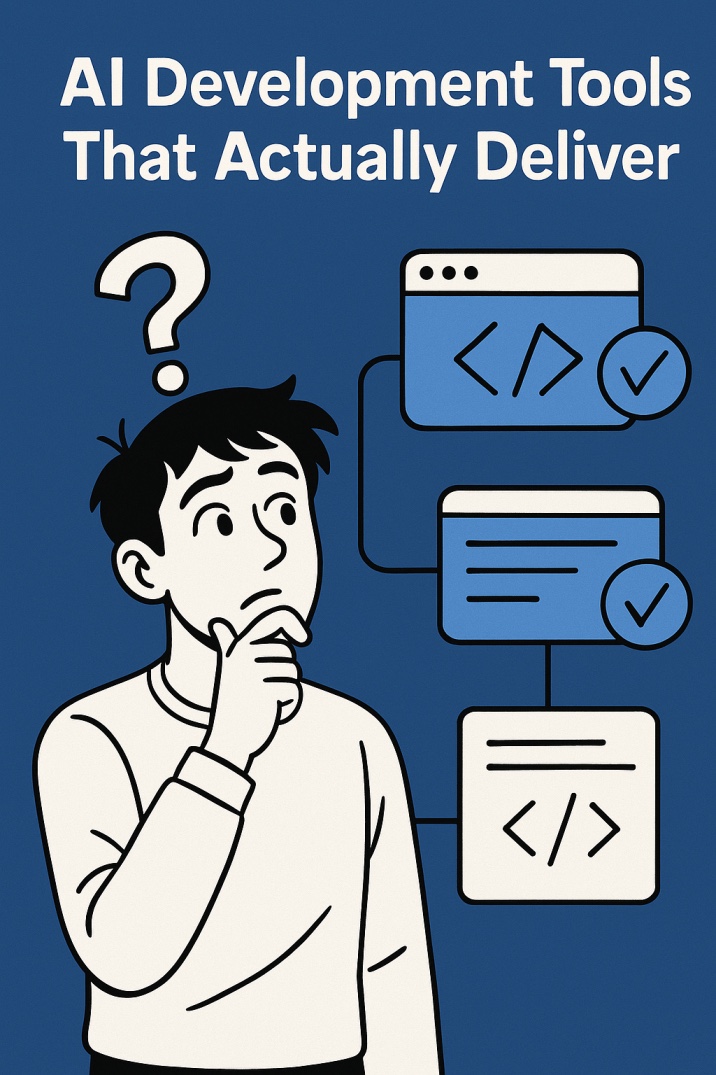AI isn’t just hype anymore — it’s deeply embedded in modern software development. From writing and reviewing code to testing, documentation, and deployment, AI tools are changing how teams ship software. A 2025 survey found that 36% of tech companies now use generative AI in engineering workflows, and the trend is only accelerating.
In this post, we’ll break down six core areas where AI tools are proving their worth. You’ll get a data-backed look at how these tools impact productivity, quality, onboarding, and business outcomes — plus quotes and insights from industry leaders.
AI Code Generation
AI coding assistants like GitHub Copilot, Amazon CodeWhisperer, and Codeium are now table stakes for high-velocity dev teams.
- Performance: GitHub Copilot users complete tasks ~55% faster. CodeWhisperer reports a 57% average reduction in coding time.
- Usage at scale: Google reports that over 25% of all new code is now AI-generated — with engineers reviewing it post-generation.
- “AI tools create a significant productivity boost… and increase developer velocity.” — Industry blogger
🔹 Bottom Line: These tools handle boilerplate, reduce toil, and let engineers focus on harder problems. Still, AI is a junior coder — you’ll want strong human reviews in place.
AI-Assisted Code Reviews
From summarizing diffs to spotting security issues, AI-powered review tools like Panto, CodeQL, and Sourcegraph Cody are making pull requests smoother and faster.
- Faster PR merges: Panto reports teams cut PR cycle time by 40–60%.
- Fewer bugs: Tools like CodeAnt saw 50% fewer post-merge defects.
- Better onboarding: AI explains code patterns and enforces standards. ZoomInfo says Copilot reduced the need for supervision with new hires.
- “Combining AI speed with human judgment creates a highly efficient review baseline.” — Slack VP of Engineering
Bottom Line: Think of AI review tools as your 24/7 junior engineer — quick, consistent, and always ready to flag issues.
Automated Testing with AI
Writing and maintaining tests is tedious. AI tools like Diffblue, Codium AI, and Testim now handle this with surprising precision.
- Massive time savings: Diffblue generates tests 250× faster than manual writing.
- Self-healing tests: Testim reports 60% less maintenance overhead.
- More coverage: Teams using Codium saw 70% higher test coverage.
- “AI testing catches issues that traditional testing might miss.”
Bottom Line: Expect better coverage, fewer regressions, and faster QA — especially when tests evolve alongside code automatically.
Refactoring & Documentation
AI is helping developers tackle two notorious time sinks: refactoring and documentation.
- Time saved: Docs that took 8 hours manually now take 2.6 hours with AI.
- Up-to-date docs: GitBook AI and Mintlify auto-sync docs with code changes.
- Faster onboarding: New hires ramp up 50% faster using Sourcegraph’s Cody.
- “AI turns messy, out-of-date documentation into a living knowledge base.”
Bottom Line: Docs and refactors are no longer blockers. AI handles the grunt work — engineers focus on logic.
The Essential AI Dev Stack (2025 Edition)
Here’s what a high-functioning AI toolchain looks like today:
- Code Assistants: GitHub Copilot, Amazon CodeWhisperer, Codeium
- Review Tools: Panto, CodeQL, SonarQube ML
- Testing: Diffblue, Codium AI, Testim
- Docs & Onboarding: GitBook AI, Mintlify, Sourcegraph Cody
- CI/CD & Monitoring: Datadog Watchdog, AI-based deployment scripts
- Metrics & Velocity: Waydev, LinearB, Teamcamp
Bottom Line: The modern stack is layered. Pick tools that integrate with your IDEs, CI, and Git hosting — and measure impact consistently.
Metrics That Matter
Don’t buy the hype. Measure what counts:
- PR Merge Time: Panto users cut it by 50–65%.
- Test Coverage: Codium users report 40–70% increases.
- Defect Rate: Tools like Qodana helped teams reduce production bugs by 35%.
- Deployment Frequency: More merges = more deploys. Faster feedback loops.
- Time-to-Market: Teams with a full AI stack shaved ~32% off cycle time.
- “AI helped us save $85K per year per 10-dev team.” — Independent case study
Bottom Line: If you’re not tracking velocity, coverage, defect density, and satisfaction, you’re flying blind.
Panto AI: Practical AI for Code Reviews
Many teams struggle to make AI actionable. Panto AI changes that with features purpose-built for engineering workflows:
- PR Chat: Ask questions about a pull request and get contextual answers.
- PR Summary: Instantly understand what a PR changes — no digging through diffs.
- Full Context: Integrates with Jira, Confluence, Git, and more.
- Zero Code Retention: Enterprise-grade privacy (SOC 2, ISO 27001).
Teams using Panto report:
- 37–60% faster PR merges
- 20–30% fewer post-merge bugs
- 46% increase in deployment frequency
Bottom Line: Panto is what AI should be — secure, contextual, and built for real engineering teams.
Final Take
AI dev tools aren’t science fiction — they’re changing how we code today. The gains are real: faster coding, smarter reviews, better tests, and stronger docs. The key is picking tools that integrate smoothly, empower your team, and deliver measurable outcomes.
Track the right metrics. Treat AI as augmentation — not automation. And make sure you’ve got buy-in from both engineers and leadership.
If you’re building or scaling engineering in 2025, AI should be part of your playbook.






